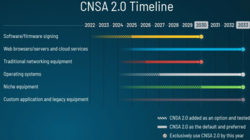Commercial National Security Algorithm Suite
The Commercial National Security Algorithm Suite (CNSA) is a set of cryptographic algorithms promulgated by the National Security Agency as a replacement for NSA Suite B Cryptography algorithms. It serves as the cryptographic base to protect US National Security Systems information up to the top secret level, while the NSA plans for a transition to quantum-resistant cryptography.[1][2][3][4][5][6]
The suite includes
- Advanced Encryption Standard with 256 bit keys
- Elliptic-curve Diffie–Hellman and Elliptic Curve Digital Signature Algorithm with curve P-384
- SHA-2 with 384 bits, Diffie–Hellman key exchange with a minimum 3072-bit modulus, and
- RSA with a minimum modulus size of 3072.[2]
The CNSA transition is notable for moving RSA from a temporary legacy status, as it appeared in Suite B, to supported status. It also did not include the Digital Signature Algorithm. This, and the overall delivery and timing of the announcement, in the absence of post-quantum standards, raised considerable speculation about whether NSA had found weaknesses e.g. in elliptic-curve algorithms or others, or was trying to distance itself from an exclusive focus on ECC for non-technical reasons.[7][8][9]
In September 2022, the NSA announced CNSA 2.0, which includes its first recommendations for post-quantum cryptographic algorithms.[10]
CNSA 2.0 includes[11]
- Advanced Encryption Standard with 256 bit keys
- CRYSTALS-Kyber and CRYSTALS-Dilithium with Level V parameters
- SHA-2 with 384 or 512 bits
- eXtended Merkle Signature Scheme (XMSS) and Leighton-Micali Signatures (LMS) with all parameters approved, with SHA256/192 recommended
Note that compared to CNSA 1.0, CNSA 2.0:
- Suggests separate post-quantum algorithms (XMSS/LMS) for software/firmware signing for use immediately
- Allows SHA-512
- Announced the selection of CRYSTALS-Kyber and CRYSTALS-Dilithium early, with the expectation that they will be mandated only when the final standards and FIPS-validated implementations are released.
- RSA, Diffie-Hellman, and elliptic curve cryptography will be deprecated at that time.
References
- ↑ Cook, John (2019-05-23). "NSA recommendations | algorithms to use until PQC". https://www.johndcook.com/blog/2019/05/23/nsa-recommendations/.
- ↑ 2.0 2.1 "Commercial National Security Algorithm (CNSA) Suite Factsheet" (in en). 2015-12-30. https://apps.nsa.gov/iaarchive/library/ia-guidance/ia-solutions-for-classified/algorithm-guidance/commercial-national-security-algorithm-suite-factsheet.cfm.
- ↑ "CNSA Suite and Quantum Computing FAQ". January 2016. https://cryptome.org/2016/01/CNSA-Suite-and-Quantum-Computing-FAQ.pdf.
- ↑ "Use of public standards for the secure sharing of information among national security systems, Advisory Memorandum 02-15 CNSS Advisory Memorandum Information Assurance 02-15". 2015-07-31. https://www.cnss.gov/CNSS/issuances/Memoranda.cfm.
- ↑ "Commercial National Security Algorithm Suite" (in en). 19 August 2015. https://apps.nsa.gov/iaarchive/programs/iad-initiatives/cnsa-suite.cfm.
- ↑ Housley, Russ; Zieglar, Lydia (July 2018) (in en). RFC 8423 - Reclassification of Suite B Documents to Historic Status. https://tools.ietf.org/html/rfc8423. Retrieved 2020-02-28.
- ↑ "NSA's FAQs Demystify the Demise of Suite B, but Fail to Explain One Important Detail – Pomcor" (in en-US). 9 February 2016. https://pomcor.com/2016/02/09/nsas-faqs-demystify-the-demise-of-suite-b-but-fail-to-explain-one-important-detail/.
- ↑ "A riddle wrapped in a curve" (in en). 2015-10-22. https://blog.cryptographyengineering.com/2015/10/22/a-riddle-wrapped-in-curve/.
- ↑ Koblitz, Neal; Menezes, Alfred J. (2018-05-19). "A Riddle Wrapped in an Enigma". Cryptology ePrint Archive. https://eprint.iacr.org/2015/1018.
- ↑ "Post-Quantum Cybersecurity Resources". https://www.nsa.gov/Cybersecurity/Post-Quantum-Cybersecurity-Resources/.
- ↑ "Announcing the Commercial National Security Algorithm Suite 2.0". https://media.defense.gov/2022/Sep/07/2003071834/-1/-1/0/CSA_CNSA_2.0_ALGORITHMS_.PDF.
 |


